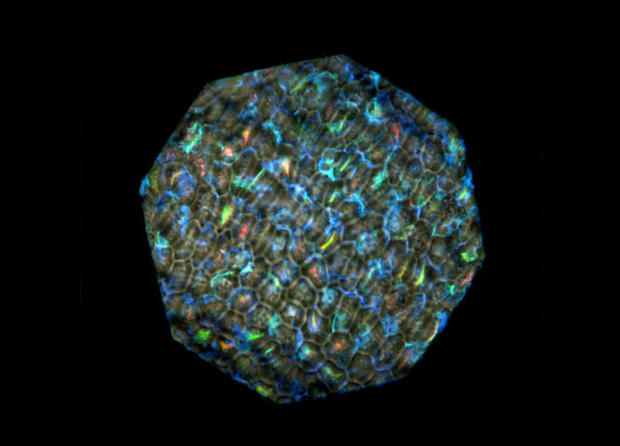Sparkling berry is nature's most colorful object
Edited at 9:32 EDT
(CBS News) They could be mistaken for Christmas tree ornaments. The sparkling orbs seen above are tiny African berries, called Pollia condensata. These metallic berries reflect more light than any natural organism and stay vibrant for years or even decades after they have been picked.
The glittering African fruit grows in the forests of Eastern Africa - particularly in Ethiopia, Tanzania and Uganda. The berries have long been used as ornamentation but are completely inedible due to their unusual composition.
It's not pigment that creates P. condensata's brilliant hues but the cell structure of the plant itself. Researchers from Britain's University of Cambridge found that the berry is composed of tightly wound cellulose strands at the cellular level. Microscopic differences in the spacing of each strand cause each cell to reflect light at a slightly different wavelength, resulting in the iridescent color of the berry. This process is known as structural coloration.
"The optics are impressive," Silvia Vignolini, one of the authors of the study, told Nature. "There are no previous examples of this in nature."
Structural coloration is well-documented in the animal kingdom - the tail feathers of a peacock are one example - but was previously unknown in plants. Researchers found the cells of P. condensata to be more colorful than any known living tissue. The tiny berries reflect 30 percent of light as compared to a silver mirror.
The microscopic cellulose strands are the reason the berries retain their color for years after the plant is picked, as the sparkling color is literally built into the plant. There is no pulp in the berry to rot and no pigments that might fade.
Why P. condensata evolved this spectacular coloration is still up for debate. The berries offer no nutritional value and cannot be eaten or preserved. Beverley Glover, a University of Cambridge plant scientist and co-author of the study, suggests that the sparkling berries attract birds who use the plant to decorate their nests.
"This strategy is brilliant as the plant does not waste any precious energy on providing food for birds." Glover told Nature.
The study was published in the "Proceedings of the National Academy for Sciences."
